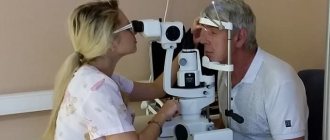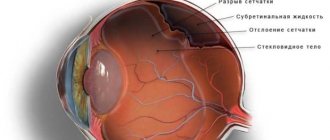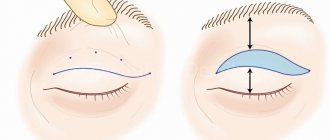Since childhood, a stereotype has been imposed on us that large eyes are the main sign of beauty (heroines of fairy tales, cartoons). And make-up artists claim that with the help of makeup, a woman with mediocre appearance but large, expressive eyes can be turned into a real conqueror of men’s hearts. No wonder that eye enlargement surgery is becoming more and more popular every day.
Many will object: “Is this possible?! You can’t make your eyes bigger.” Below you will read a detailed answer to this question.
The essence of eye enlargement surgery
Indeed, it is impossible to increase the size of the eyes surgically. But removing part of the skin from the upper “overhanging” eyelid, fatty hernias under the eyes, tightening the ciliated edge, changing the shape of the eyes is quite possible. All surgical interventions to change the size of the eyes have a common name - sangapuri (translated from Japanese as the fold of the upper eyelid) or blepharoplasty of Asian eyes.
Why Asian? Yes, because for the first time this intervention began to be carried out in Japan, since the dream of many women of the “east” is European eyes. Among them, this operation is the most popular. However, Europeans are increasingly resorting to it. After all, with the help of blepharoplasty, you can not only change the size of the eyes, but also tighten the eyelids, due to which the eyes become more expressive and the face acquires a youthful appearance.
An equally popular method is epicanthoplasty, which involves removing the epicanthus - the fold above the inner corner of the eye, and canthoplasty - surgery to cut the eye .
The difference between canthoplasty and blepharoplasty: with the first, excess fat and dermis are removed on the upper eyelid, and with the second, on the lower eyelid through incisions in the outer corners of the eyes.
Plastic surgery methods for the eyes
In modern plastic surgery, there are two main methods of performing blepharoplasty:
Laser – cuts are made with a laser beam;
Surgical – “access” is opened with a scalpel
All interventions in plastic surgery on the eyes last no more than an hour and a half. They are performed either under general anesthesia (preferably for circular blepharoplasty), or under local anesthesia based on adrenaline and 1-2 lidocaine solutions. The patient must remain in the clinic for two hours after surgery to avoid complications.
Sutures after plastic surgery of the eyes are removed on the 3-4th day - in the case of classical blepharoplasty, but if the operation was performed transconjunctivally, then they are not applied at all.
After blepharoplasty, bruising and some swelling may persist around the eyes for 1-2 weeks. In general, this is a normal phenomenon - you just need to wait it out.
Involves eye correction in the upper eyelid area. As a result, “heavy” overhang is eliminated and excess skin is removed. For manipulation, the plastic surgeon makes an incision in the area of the natural fold located in the area of the upper eyelid, after which he removes the excess flap of skin, and, giving himself access to the fatty tissues, he removes them too. The incision is sutured here with an internal seam and special thin threads. As a result, after 1-2 months the scar becomes completely invisible even to the patient himself.
With blepharoplasty on the lower eyelid, an incision is made 1-2 millimeters below the eyelash line. During the operation, the surgeon first trims off some of the excess skin, after which he opens and removes tissue from the fat sacs, which are fat hernias. Sometimes lower blepharoplasty, on the contrary, does not eliminate fat deposits, but adds a little, distributing them evenly over the “lower” zone.
After this, internal sutures are applied, which, as in the first case, after about 1-2 months completely fade and become completely invisible.
This is a simultaneous correction of the lower and upper eyelids.
This eye plastic surgery technique is most popular among people of Asian appearance. The intervention, which is also called canthoplasty, allows you to transform the single fold of the upper eyelid, which is characteristic of the Asian population, into a double fold, similar to the one we have. During the operation of plastic surgery of the eye incision, the epicanthus (a characteristic overhang of the skin fold in the inner corner of the eye) is eliminated with the simultaneous formation of a double crescent fold. Excess fat deposits around the eyes are also removed.
But Asian appearance is not the only indication for eye plastic surgery, that is, in addition to correcting the folds of the upper eyelid. This intervention can correct the shape of the eyes, their shape, and tighten their drooping outer corners. Canthoplasty is no more traumatic than other types of blepharoplasty.
On average, the recovery period takes from 2 to 6 weeks. People who do not smoke and strictly follow all postoperative recommendations of the surgeon can count on the minimum terms:
- for 7-10 days the patient should wear tinted glasses;
- for about 10-14 days you need to stop wearing contact lenses in favor of glasses;
- avoid physical exertion, sudden movements, bending, etc., as this can cause rupture of the seams;
- You need to avoid cosmetic procedures for at least a month;
- Makeup is allowed only 10 days after surgery.
To identify factors that impede plastic surgery on the eyes, the following tests are performed:
- general blood analysis;
- blood for coagulogram;
- blood chemistry;
- cardiologist's report based on ECG;
- endocrinologist's conclusion;
- ultrasound of the abdominal organs;
- blood test for HIV;
- visiting a psychologist.
In recent years, prices for plastic surgery have dropped significantly. This is mainly due to the technologization of this area, but not to a decrease in the quality of services provided. Previously, plastic surgeons operated mainly with only one scalpel and using outdated techniques, making large and deep incisions that left quite noticeable scars. Today, these techniques are replaced by more affordable high-tech techniques that allow any surgical intervention to be carried out quickly and minimally invasively. Due to this, the price of plastic surgery has become more affordable for ordinary people. And, for example, today blepharoplasty can be done for 250 - 300 USD. e., whereas 10 years ago the price for plastic surgery of the lower and upper eyelids exceeded 1000 USD. e.
Indications
Indications for the procedure are as follows:
- “Mongoloid” eyes (swelling of the upper eyelid fold and epicanthus);
- narrow eyes;
- age-related changes in the eyelids (overhanging fold of the upper eyelid above the eye);
- bags under the eyes;
- “round bulging” eyes;
- asymmetry;
- consequences of inflammatory processes;
- congenital pathologies (incomplete cleft eyelid);
- deformations due to injuries, burns, etc.
Advantages and disadvantages
pros
- Aesthetic shortcomings are eliminated.
- The face becomes younger and fresher.
- Wrinkles are smoothed out.
- Asymmetry is eliminated.
- Beautiful cat look.
Minuses
- Relatively high cost of the operation.
- Many restrictions related to the patient's health.
- Risk of complications.
- Lifestyle changes during the rehabilitation period.
- Difficulties in choosing a competent specialist.
Alternative methods of eyelid correction
- Thermolifting. Strengthening the skin framework due to thermal effects.
- Thermage. Impact on the muscle frame using radio waves.
- Laser blepharoplasty. The correction is carried out without surgery using a laser.
- Plasma is a relatively new method. Due to the introduction of plasma, old tissues are renewed and natural tissue regeneration occurs. More details about this can be found here.
- Hyaluronic acid injections.
- Facebuilding or gymnastics for the face.
- Regular massage.
It is worth noting that these methods will not be effective and it is better to choose the surgical method if the patient wants to radically change the shape and shape of the eye, as well as in the case of pronounced ptosis of the eyelids and it is better to choose the surgical method.
Hardware and injection techniques must be carried out regularly, while surgical intervention solves the problem in one procedure and the result lasts for many years without the need for repeated procedures.
We talked about all types of blepharoplasty here, and if you are interested in learning about non-surgical techniques, then read this article.
Technique for eye surgery
The technique of eye enlargement surgery depends on the method that underlies it. But conditionally, all types of sangapuri can be divided into the following stages:
- Anesthesia (general anesthesia or local anesthesia).
- Making an incision (outer corner of the eye - to increase the eye section (up to 5 mm), folds above the upper eyelid - to increase it (1, maximum 2 cm), etc.
- Removal of excess fatty tissue and skin at the incision site.
- Stitching.
If the skin of the patient's eyelids is too thin, then aesthetic blepharoplasty is performed as follows: sutures are placed between the muscles that are responsible for lifting the eyelid. Thus, a fold of the upper eyelid is formed without making incisions.
The duration of the operation depends on the method and ranges from 30 minutes to 2 hours. If the procedure was carried out under general anesthesia, then you need to stay in the hospital for 1-4 days; under local anesthesia, you can leave the clinic after a few hours.
Before and after
Canthoplasty: types and results
Intervention to change the shape of the eyes today is considered to be a routine, relatively uncomplicated procedure. Depending on the goals, the surgeon decides on the technique to perform. There are several varieties:
- Canthopexy. It is a correction of the outer corners of the eyes, performed under local anesthesia for about 2 hours. During the operation, the surgeon makes an incision on the outer corner, removes the tendon and tightens it to the periosteum with suture material. When tensioned, it is adjusted and the new position of the outer corner is fixed.
- Lateral. The purpose of the method is to stretch the cut, giving special expressiveness to the look. It often complements traditional blepharoplasty and improves the appearance of the skin in the periorbital area.
- Medial or median. The procedure solves the problem of defects in the inner corners and models an expressive almond-shaped gaze. Medial correction also goes well with other beauty procedures.
- Epicanthoplasty. It is carried out to remove large folds of skin and subcutaneous fat. This type is especially popular among those with an Asian cut and severe ptosis.
The doctor decides on treatment tactics at the consultation stage. At the same time, they design a future new look and discuss the wishes of the patient himself.
Recovery
The day after the intervention, treatment of the sutures and skin at the site of manipulation is necessary. Sutures are removed on the 4th day after surgery, swelling and hematomas disappear on average on the 10th day. It takes 2 months for complete recovery. During the rehabilitation period you should:
- avoid heavy physical activity;
- avoid getting moisture on your eyelids, and also try not to cry;
- apply compresses and instill eye drops with antibacterial agents (as recommended by a doctor);
- contact specialists for a restorative massage of the skin.
Complications after surgery
Even if the intervention is performed by an experienced surgeon, there is a risk of certain types of complications:
- after some time the seams may come apart;
- the incision site may burn;
- the skin of the eyelids will become dry;
- conjunctivitis, blepharoptosis or hematomas will appear;
- if the operation affected the upper eyelid, then after some time it may turn out;
- Eye asymmetry may occur.
But the appearance of small bruises after surgery and swelling on the eyelids is the norm. They will pass in literally 14 days.
As for the rehabilitation period, if general anesthesia was performed, the patient is kept in the hospital for another day so that doctors can monitor his condition. When local anesthesia has been used, the person is given a bandage and after a few hours (as soon as it is removed) he can go home.
In parallel with this, compresses are applied to the eyes - they help to quickly remove swelling. It is also necessary to put antibacterial drops into the eyes, which will prevent infection.
The recovery process itself takes no more than 2 months. If you listen to all the doctor’s recommendations, then after 60 days the eyes will take a new shape, and all signs of surgical intervention will disappear without a trace.
Possible consequences
As with any other intervention, eye enlargement surgery is fraught with the following complications:
Immediately after the operation you will be concerned about:
- pain;
- swelling;
- hematomas;
- burning.
Over time, the following complications are possible:
- conjunctivitis, increased activity of the lacrimal glands or dry eyes;
- separation of scars;
- wound infection;
- eversion of the eyelid;
- asymmetry;
- temporary visual impairment;
- ptosis;
- protrusion of the eyeball;
- diplopia (double vision);
- orbital hemorrhage (from 1 to 7 days after surgery) and loss of vision.
Displacement and other complications and side effects after mammoplasty
In some cases, surgery can provoke the following complications:
- Implant displacement after mammoplasty. Implant displacement may be noticed after swelling subsides after surgery. It can Signs of implant displacement after mammoplasty? manifest itself as breast asymmetry, sagging and deformation of the areola. Apart from aesthetic dissatisfaction, this phenomenon is not dangerous, but if the displacement is pronounced, repeated surgery is required.
- The implant is palpable after mammoplasty. What should you do if you can feel the implant after mammoplasty? If the implant can be clearly felt when pressing on the chest, and its contours are visible, adding fat through lipolifting or replacing implants with denser ones can correct the situation.
- You can feel the implant after mammoplasty. What if you feel the implant after mammoplasty? At first, the feeling of the implant as a foreign body is a normal phenomenon, which should subside over time. But if the sensation does not go away, we may be talking about capsular contracture. In some cases, massage and certain medications in the form of injections are sufficient to eliminate the problem, while in others surgical intervention is required.
- Suppuration of the postoperative suture. This is one of the most dangerous complications, in which the breast swells greatly, the temperature rises, and pus is released from the nipple or the suture itself. The process can be eliminated with antibacterial agents, but in some cases surgery is necessary.
- Loss of sensation. At first, this phenomenon is normal. If it does not go away, massage and physiotherapy are prescribed.
Read more about how to understand that breast surgery was unsuccessful and what to do in a separate article.
We invite you to watch a video about possible complications after mammoplasty:
You may be interested in reading our other articles about what reduction and augmentation mammoplasty are, as well as how and when nipple and areola correction surgery is performed.
What effect should you expect?
The first results will be visible after the swelling subsides (approximately a month after surgery). And after 2-3 months you can admire the “new” eyes, because after the operation:
- a double fold will appear on the upper eyelid (if it is absent);
- bags and wrinkles under the lower eyelid will disappear;
- the overhang of the upper eyelid over the eye will be eliminated;
- the gaze will “open”, become expressive, the size of the eyes will visually increase, and the face will become significantly “younger”.
Regarding the durability of the effect, doctors give an average of up to 15 years (age-related changes make the results less noticeable every year).
Before and after
Preparing for surgery
Preoperative examination before iris surgery includes mandatory ophthalmoscopy and biomicroscopy of the eye. Also necessary procedures include monitoring intraocular pressure, which is carried out using non-contact tonometry. In addition, to perform the operation, it is necessary to perform visometry and ultrasound of the eye (B-scan). According to individual indications, OCT may be prescribed.
In order to reduce the risk of possible postoperative complications during the period of preparation for surgery, a short course of antibiotics, as well as non-steroidal anti-inflammatory drugs, is recommended.
Reviews
Reviews about the procedure are mostly positive. The patients are satisfied with the results obtained.
The disadvantages include the inconvenience of the recovery period: the inability to sleep on your side, leave the house for the first time, wear dark glasses, etc.
Some girls claim that during the rehabilitation period they experienced a temporary deterioration in vision, as well as burning and itching.
Remember that eye enlargement surgery sometimes carries unnecessary risks, since the new size of your eyes does not always harmonize with the rest of your facial features! But to prevent this from happening, you should choose the right doctor!
December 6, 2021 by anna
How the operation is performed
Before the intervention, you should take a shower and remove all makeup from your face, remove contact lenses, remove jewelry and change into special clothes. The procedure algorithm is as follows:
- The patient lies on his back on the couch, and the doctor marks the incision lines on the skin with a marker. The assistant treats the face and neck of the person being operated on with an antiseptic solution, after which the entire body and face of the patient is covered with a sheet so that only the eye area remains exposed.
- Next, anesthesia is administered, local or general, after which the doctor begins to eliminate the defects.
- At the end of the operation, stitches are applied and, if necessary, a sterile bandage or plaster is applied.
Plastic surgery today is an accessible, reliable and safe way for everyone to solve the problem of early aging of the skin around the eyes.
The recovery period after blepharoplasty lasts from several days to several weeks, depending on the age of the patient and the nature of the interventions. Your doctor will tell you in detail how to behave correctly after surgery. Failure to comply with the rules of the postoperative regimen can lead to serious consequences, which are not always possible to correct.











